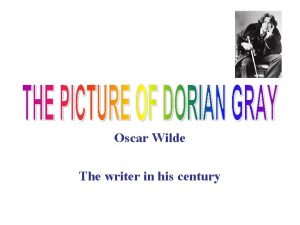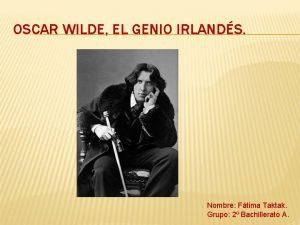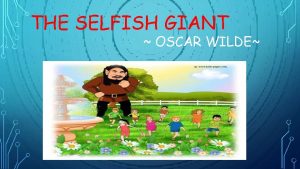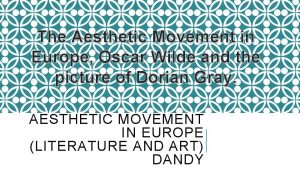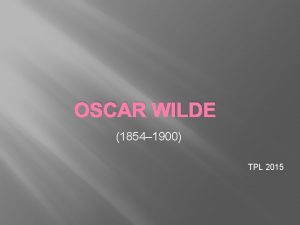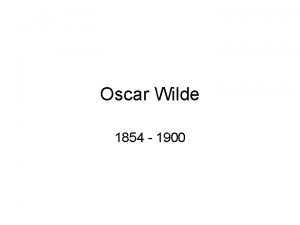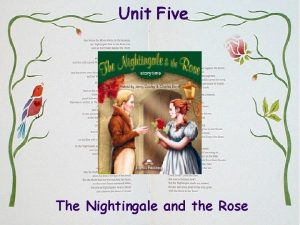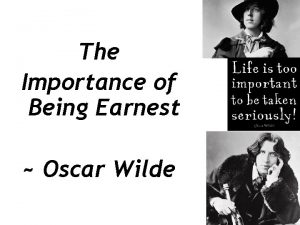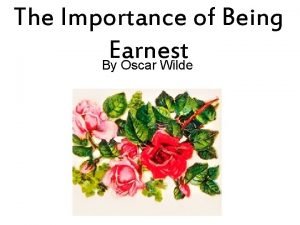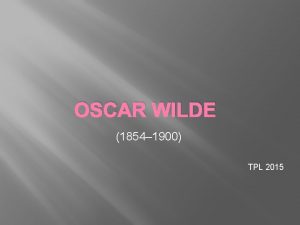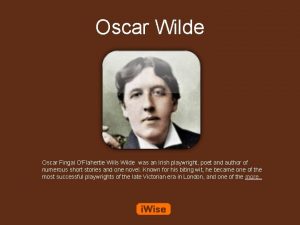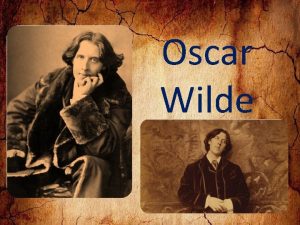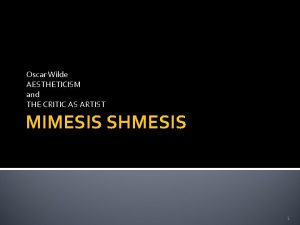Oscar Wilde Hedonism and Aestheticism 2003 Pearson Education












- Slides: 12

Oscar Wilde, Hedonism and Aestheticism © 2003 Pearson Education, Inc. , publishing as Longman Publishers.

Oscar Wilde (1854 -1900) • Wrote mostly plays with satirical themes, but also created poems and other works. • He was born in Dublin in 1854 and died in 1900 due to bad health. • Attended Trinity College in Dublin and a Magdalen College, in Oxford. • Put on trial about his play, "The Importance of Being Earnest", where Oscar was accused of being a sodomite. • He was found guilty and sent to prison which was the beginning of his downfall. • He died poor, © 2003 and alone in a hotel room in Paris. Pearson Education, Inc. , publishing as Longman Publishers.

The Picture of Dorian Gray Literary Elements There can be Faustian elements seen in this story. For eternal youth, he gave his soul to the painting, and slowly became morally corrupt and evil. It also points out the evils of society, that looks are more important that anything else. Foreign influences also corrupt a once pure Dorian. Hedonism and Aestheticism © 2003 Pearson Education, Inc. , publishing as Longman Publishers.

HEDONISM To a HEDONIST, happiness is having all the pleasure one can obtain. © 2003 Pearson Education, Inc. , publishing as Longman Publishers.

Assumptions of hedonism: • Everyone deserves as much pleasure as possible. • Pleasure is automatically good. • No amount of pleasure is ever too much. • The absence of pleasure is a misfortune for which compensation is due. • Nothing but pleasure is intrinsically good. © 2003 Pearson Education, Inc. , publishing as Longman Publishers.

• The Hedonist will claim that all pleasure is intrinsically good. Of course, other things are good, too – liberty, for example. However, liberty is only good instrumentally, as a means towards greater happiness. • Pain as a means to pleasure. Pain is intrinsically bad. However, it is sometimes good as a means. © 2003 Pearson Education, Inc. , publishing as Longman Publishers.

Hedonism Reconsidered: Hedonism has inspired critical questions: 1. Is this philosophy based on an accurate view of human nature? 2. Is it accurate to assume that people are pleasure-loving at all times and in all places? 3. Is it self defeating to assume that happiness is the sum total of all possible pleasures? 4. What is the difference between happiness and pleasure? © 2003 Pearson Education, Inc. , publishing as Longman Publishers.

AESTHETICISM emphasized the importance of Art and Beauty as a means progress; worshipped beauty above everything. © 2003 Pearson Education, Inc. , publishing as Longman Publishers.

“Art for Art’s sake” sake meant: art for the pleasure and sensations that it could produce, produce without any regard to standards of morality or utility. © 2003 Pearson Education, Inc. , publishing as Longman Publishers.

The fundamental principles of this movement were the following: 1. The cult of beauty 2. The choice for a life beyond common morality 3. The solution of the dichotomy between senses and spirit through theory of the spiritualization of the senses 4. The reversal of the principle of art imitating life into that of life imitating art. © 2003 Pearson Education, Inc. , publishing as Longman Publishers.

Walter Pater (1839 -1894) • Pater was the defender of hedonism, hedonism a doctrine according to which pleasure is the chief good to be pursued by man • In his opinion , life should be treated as a work of art. • In his “Studies in the history of Renaissance”(1873) he stated that: 1. “the secret of happiness lies in the enjoyment of beauty”; beauty 2. “the finest sensations are to be found in art”; art 3. “the deepest and noblest emotions can be experienced in a life meant as a work of art. ” • Through our senses we can enjoy any form of artistic beauty and thus live a deep spiritual experience © 2003 Pearson Education, Inc. , publishing as Longman Publishers.

Concept Map Directions 1. Create a concept map that illustrates all of the elements of either Hedonism OR Aestheticism 2. Create off-shoots to clarify each aspect of the movement by giving several examples. 3. You must have at least five main “offshoots” and they must each have at least 5 other “off-shoots” or “branches”. Connect your thinking. 4. Be creative! Add pictures, captions, and other notes to enhance your presentation.
 Texte anglais bac
Texte anglais bac Canterville ghost
Canterville ghost El genio irlandes
El genio irlandes Trespassers will be prosecuted selfish giant
Trespassers will be prosecuted selfish giant Dorian grey effect
Dorian grey effect Oscar wilde sebični div
Oscar wilde sebični div Aesthetic movement oscar wilde
Aesthetic movement oscar wilde Dorian gray portree film
Dorian gray portree film Oscar wilde dandyism
Oscar wilde dandyism Amigo que não ri junto
Amigo que não ri junto The nightingale and the rose summary
The nightingale and the rose summary Situational irony in the importance of being earnest
Situational irony in the importance of being earnest Who is the protagonist in the importance of being earnest
Who is the protagonist in the importance of being earnest
